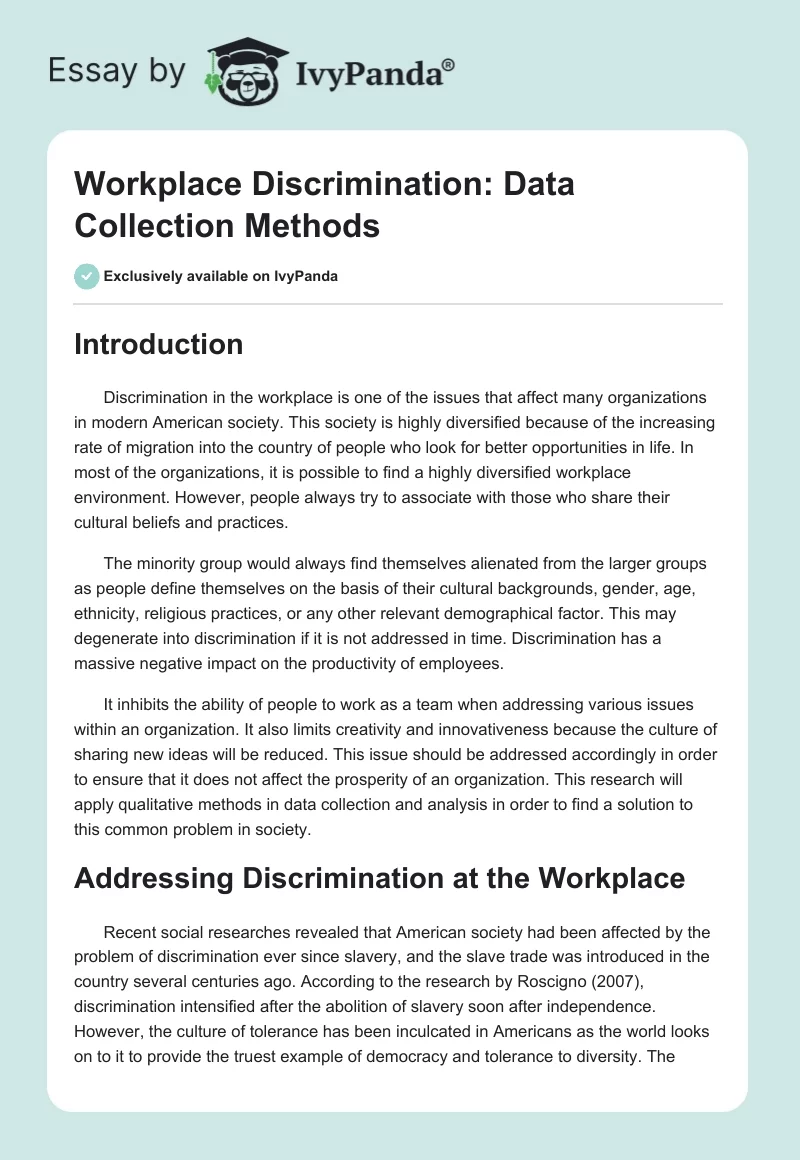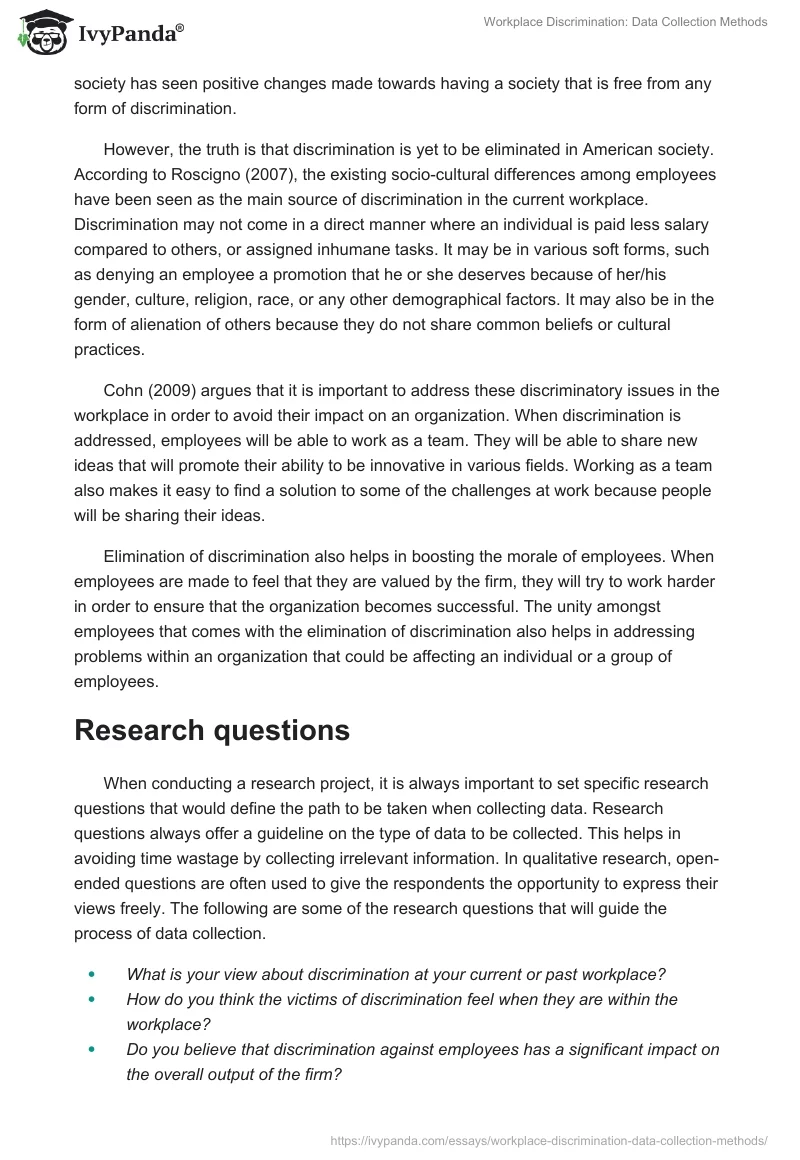Introduction
Discrimination in the workplace is one of the issues that affect many organizations in modern American society. This society is highly diversified because of the increasing rate of migration into the country of people who look for better opportunities in life. In most of the organizations, it is possible to find a highly diversified workplace environment. However, people always try to associate with those who share their cultural beliefs and practices.
The minority group would always find themselves alienated from the larger groups as people define themselves on the basis of their cultural backgrounds, gender, age, ethnicity, religious practices, or any other relevant demographical factor. This may degenerate into discrimination if it is not addressed in time. Discrimination has a massive negative impact on the productivity of employees.
It inhibits the ability of people to work as a team when addressing various issues within an organization. It also limits creativity and innovativeness because the culture of sharing new ideas will be reduced. This issue should be addressed accordingly in order to ensure that it does not affect the prosperity of an organization. This research will apply qualitative methods in data collection and analysis in order to find a solution to this common problem in society.
Addressing Discrimination at the Workplace
Recent social researches revealed that American society had been affected by the problem of discrimination ever since slavery, and the slave trade was introduced in the country several centuries ago. According to the research by Roscigno (2007), discrimination intensified after the abolition of slavery soon after independence. However, the culture of tolerance has been inculcated in Americans as the world looks on to it to provide the truest example of democracy and tolerance to diversity. The society has seen positive changes made towards having a society that is free from any form of discrimination.
However, the truth is that discrimination is yet to be eliminated in American society. According to Roscigno (2007), the existing socio-cultural differences among employees have been seen as the main source of discrimination in the current workplace. Discrimination may not come in a direct manner where an individual is paid less salary compared to others, or assigned inhumane tasks. It may be in various soft forms, such as denying an employee a promotion that he or she deserves because of her/his gender, culture, religion, race, or any other demographical factors. It may also be in the form of alienation of others because they do not share common beliefs or cultural practices.
Cohn (2009) argues that it is important to address these discriminatory issues in the workplace in order to avoid their impact on an organization. When discrimination is addressed, employees will be able to work as a team. They will be able to share new ideas that will promote their ability to be innovative in various fields. Working as a team also makes it easy to find a solution to some of the challenges at work because people will be sharing their ideas.
Elimination of discrimination also helps in boosting the morale of employees. When employees are made to feel that they are valued by the firm, they will try to work harder in order to ensure that the organization becomes successful. The unity amongst employees that comes with the elimination of discrimination also helps in addressing problems within an organization that could be affecting an individual or a group of employees.
Research questions
When conducting a research project, it is always important to set specific research questions that would define the path to be taken when collecting data. Research questions always offer a guideline on the type of data to be collected. This helps in avoiding time wastage by collecting irrelevant information. In qualitative research, open-ended questions are often used to give the respondents the opportunity to express their views freely. The following are some of the research questions that will guide the process of data collection.
- What is your view about discrimination at your current or past workplace?
- How do you think the victims of discrimination feel when they are within the workplace?
- Do you believe that discrimination against employees has a significant impact on the overall output of the firm?
- What do you believe is the best way of addressing the issue of discrimination in the workplace?
Method of Investigation
This research will use qualitative methods to collect and analyze data. The researcher will use unstructured interviewing; one of the popularly used qualitative research methods. According to Liamputtong (2009), “Unstructured interviewing involves direct interaction between the researcher and a respondent or group” (p. 67). The researcher will use open-ended questions to gather information from the participants. It allows the respondents to think and answer questions based on their own views, unlike the structured questions that restrict answers to yes or no.
Unstructured interviewing will be the best approach to this research because of the nature of the topic. The researcher is aware of the fact that some of the respondents may be victims or perpetrators of discriminatory acts. For this reason, a structured question would not be appropriate in collecting the information (Tracy, 2013). The responses given by the victims of discrimination may not be the same as those of the perpetrators. While the former will try to explain the pain of having to work in a discriminative environment, the latter will try to offer a justification for their actions.
Strengths of Qualitative Methods
The researcher considered qualitative methods to be appropriate for this research for a number of reasons. When investigating the reasons behind and the impact of discrimination at workplace, this method would allow the researcher to get the views of the respondents that will help to explain why some people engage in this vice, and how the victims are affected. This will also help to understand the impact of discrimination on the performance of an organization. The following are some of the factors that make this method superior.
- Qualitative methods allow the respondents to answer the questions based on their own understanding.
- It is easy to know the attitude of the researcher towards the subject of the question based on their responses.
- The researcher is able to gather information about the firm that would not have been collected when using quantitative methods.
- Qualitative methods help the researcher to get a detailed explanation as to why a given event took place the way it did and the level of impact it had on the affected individuals.
- The face-to-face interaction during the interview will help in motivating the participants to ask any questions that they may have towards the project. This will increase their chances of participating in the research.
It is because of the above factors that the researcher considered it appropriate to use qualitative methods in this study.
Weaknesses of Qualitative Methods
According to Guven (2008), qualitative research has some weaknesses that may affect its ability to yield the required information in a research process. It is important to identify these weaknesses before starting the research in order to understand how they can be addressed. The following are some of the weaknesses that this approach has.
- Data collection through open-ended questions is always time consuming. Some respondents may take very long time to explain a simple concept that only requires a simple answer.
- The data collected through qualitative methods is always voluminous because the respondents are allowed to explain their views on the subject under investigation.
- Analyzing qualitative data can be complex, especially when there is a big variation in the responses given by the participants. Sometimes it may force the researcher to analyze the individual responses of the participants.
The above weaknesses may affect the quality of the research if they are not taken care of properly in the study. However, the researcher is aware of their impact on the quality of the research, and precautionary measures will be taken.
Expected Findings
The findings of this research are expected to discover the causes of discrimination and a detailed explanation of its impact on an organization. The most common cause of discrimination is the inability of some people to accept the existence of diversity in the society. The feeling that one group is better than another is the common reason of discrimination in the workplace. Once a certain group starts to behave as though they are superior to others, then differences would arise and this would result into discriminatory acts. Discrimination is one of the leading factors of poor performance in many organizations in the country.
When people fail to fight discrimination, it may develop into anarchy within the workplace. Employees will classify themselves along the lines of race, religion, age, gender, or any other demographical factor. It would limit the ability of these employees to integrate into a single unit that is focused on achieving mutual interests within an organization. Each group will try to focus on self-gains at the expense of the overall organizational success. Instead of working as a team to address challenges of a firm, employees will take most of their time trying to assert their position as members of a certain group. In other cases, such discrimination may lead to verbal or physical assault.
There have been cases in the past where some people have been attacked at workplaces because of their race or religious beliefs. When the discrimination reaches such extreme levels, then the workplace may no longer be safe. If this is not addressed properly, then such an organization may not be able to achieve success, because the employees will not be able to maximize their potential. Their attention will either be diverted to how they can protect themselves from their aggressors, or how they can organize retaliatory attacks. Even minor discriminatory acts may affect some employees psychologically, and may inhibit their performance within the organization.
References
Cohn, S. (2009). Race, Gender, and Discrimination At Work. New York: Westview Press.
Guven, L. M. (2008). The Sage encyclopedia of qualitative research methods. Los Angeles: SAGE.
Liamputtong, P. (2009). Qualitative research methods. South Melbourne, Vic: Oxford University Press.
Roscigno, V. J. (2007). The face of discrimination: How race and gender impact work and home lives. Lanham, Md: Rowman & Littlefield.
Tracy, S. J. (2013). Qualitative research methods: Collecting evidence, crafting analysis, communicating impact. Malden, MA: Wiley-Blackwell.


